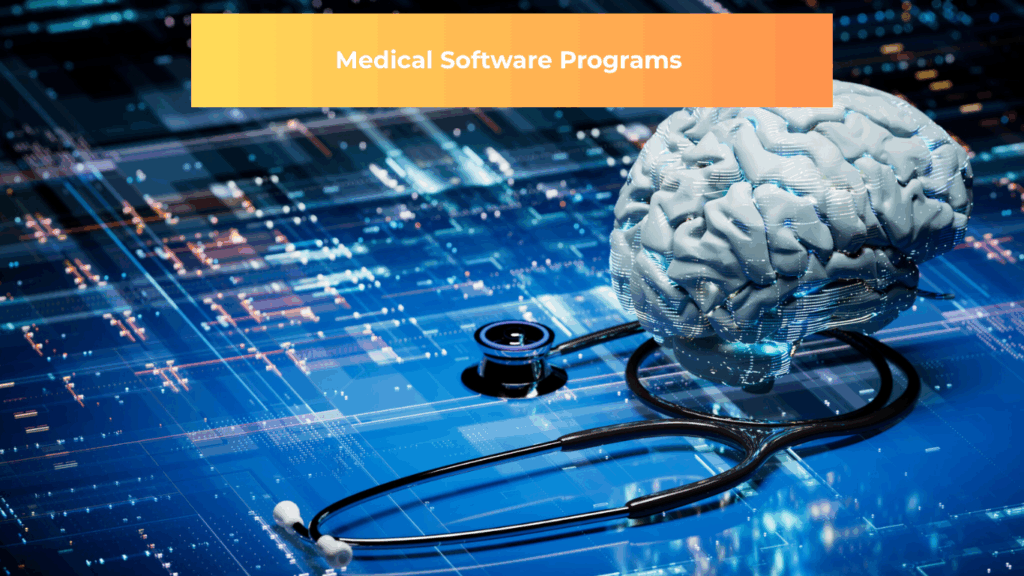See how Medical Software Programs take the busywork out of healthcare—helping doctors care more and worry less. Let HBLAB craft the right medical software for your team and your patients.
Imagine walking into a clinic where doctors spend more time with patients and less time buried in paperwork. For many, though, this isn’t the reality—over 90% of physicians regularly struggle with burnout, with about two-thirds overwhelmed by endless forms and administrative chores. It’s a tough cycle: nurses and doctors want to focus on care, but get bogged down by scheduling, billing, and compliance.

That’s where medical software programs step in. From intuitive EHRs to AI-powered diagnostic tools and seamless mobile apps, today’s medical computer software programs are quietly transforming healthcare behind the scenes. They free up clinicians, streamline operations, and put precision and patient experience front and center.
In this guide, we break down the major types of medical software, real-world benefits, evolving challenges, and what’s ahead for 2025.
What Are Medical Software Programs?

Medical software programs are purpose-built digital tools designed to make life easier for doctors, nurses, and patients alike. Imagine trading in those overflowing file cabinets and endless paper forms for secure, cloud-based systems where every patient record, appointment, or bill is just a click away.
Today’s medical computer software programs do far more than just store information—they help schedule visits, automate billing, flag potential issues, and even guide diagnostic decisions through built-in AI. In many ways, these programs have become the silent backbone of every modern clinic and hospital, turning complex workflows into smooth, coordinated care.
The IT Outsourcing Advantage for Medical Software Programs
So why are more healthcare organizations turning to outsourcing for medical software development? Picture it like bringing in an award-winning chef for your busy kitchen: you get world-class expertise, fresh ideas, and faster results, without the headache of hiring and training an in-house team.
By outsourcing, clinics and hospitals gain access to specialized global talent, the latest technologies like AI and secure cloud solutions, and the flexibility to scale projects up or down as needed.
Best of all, outsourcing can trim development costs by up to 40%, allowing healthcare providers to invest more in what matters most: delivering outstanding patient care, powered by smarter software.
🌟 Explore HBLAB’s medical software solutions today!
Key Types of Medical Software Programs Powering Healthcare
The world of medical software is full of digital helpers—each designed to solve real problems for clinics, hospitals, and patients. Here are eight types of medical software programs that are truly transforming healthcare in 2025:
1. Electronic Health Record (EHR) Software
Think of EHRs as the digital heart of healthcare. These programs safely store every detail of a patient’s health story—diagnoses, medications, allergies, and lab results—all in one organized, secure system. EHR programs make it easy for providers to share information in real time, helping reduce mistakes and keep care teams in sync. Patients benefit, too, with portals to view test results, book appointments, and stay in control of their own health.
2. Hospital and Practice Management Software
Running a clinic or hospital is no small feat. Medical management software programs help by handling scheduling, inventory, billing, and even staff assignments. By integrating with EHRs, they cut down on wait times, improve patient flow, and free up hours for staff every single day, making operations smoother for everyone from the front desk to the exam room.
3. Medical Billing and Coding Software
No one likes billing headaches! Medical coding software programs take the hassle out of turning visits, tests, and treatments into accurate insurance claims. These tools translate medical care into universal billing codes, reduce costly errors, and speed up reimbursements. The result? Less frustration for clinics and quicker answers for patients about what they owe.
4. Medical Diagnosis Software
AI-driven medical software is lending a keen set of digital eyes to the diagnostic process. These programs analyze symptoms, history, or even medical images to help doctors spot patterns the human brain might miss. With platforms like IBM Watson Health, clinicians are catching diseases sooner and personalizing treatment plans faster.
5. Medical Imaging Software (PACS)

When you get an X-ray or MRI, medical imaging software (PACS) makes sure those images don’t just sit on a single computer. They’re stored safely, organized, and instantly shareable—sometimes even in 3D! Specialists can collaborate across the globe, examine scans more precisely, and make informed decisions, all thanks to this powerful type of medical software.
6. Telemedicine Software
Virtual care has soared in popularity. Telemedicine software enables doctors and patients to connect through secure video or chat, no matter where they are. Solutions like Doxy.me help patients skip long commutes or crowded waiting rooms, while doctors can reach people who might otherwise be left behind.
7. Remote Patient Monitoring (RPM) & Wearable Integration
Staying healthy doesn’t end when you leave the clinic. RPM tools and wearable integrations track important health stats, such as glucose levels or heart rate, at home or on the go. This wave of IoMT (Internet of Medical Things) technology makes it possible for providers to spot emerging issues before they get serious, reducing ER trips and hospital readmissions. Patients feel supported, even from afar.
8. E-Prescribing Software
Gone are the days of messy handwriting on prescription pads. E-prescribing software lets doctors send medication orders straight to pharmacies, fast and error-free. Programs like DrFirst even check for dangerous drug interactions automatically, keeping patients safer and making it easier to stay on top of their treatment plans.
🚀 Contact HBLAB for cutting-edge medical software programs!
Benefits of Medical Software Programs for Providers and Patients
Medical software programs aren’t just digital upgrades, but they’re game-changers that touch every corner of the healthcare experience. Here’s how they’re making life better for both providers and patients, in ways that really matter:
Reduced Burnout for Care Teams
Doctors, nurses, and admin staff have long been swamped by paperwork, billing, and endless scheduling puzzles. Medical software programs step in as diligent helpers, automating the most time-consuming tasks. Imagine doctors spending less time clicking boxes and more time actually listening to their patients. This shift not only eases stress, but brings the human connection back to healthcare.
Improved Accuracy—Fewer Errors, Safer Care
With the help of AI-driven medical software, risky mistakes like misdiagnoses or clerical errors are becoming less common. When intelligent tools scan data and double-check details, nothing falls through the cracks. Providers gain peace of mind, knowing decisions are backed by smart technology—and patients feel safer, too.
Enhanced Patient Engagement and Empowerment

Today, patients don’t just sit on the sidelines. Thanks to online portals and remote monitoring apps, they can view their test results, track their vitals, message their doctor, and even manage appointments from anywhere. Many report feeling more in control and better cared for—especially with the increased reach of telehealth and remote check-ins.
Greater Cost Efficiency
By streamlining administrative work and reducing mistakes, medical software programs help clinics and hospitals save serious money. Smoother workflows mean fewer repeating tasks, less paperwork, and a lot fewer surprise costs from billing errors or denied claims. That efficiency leaves more budget for what truly matters: quality care and innovation.
Global Scalability and Seamless Collaboration
Many modern medical software programs are cloud-based, which means data can be shared instantly across cities, countries, or even continents. This is a lifesaver for multi-site hospitals or organizations managing teams in different locations. No more juggling different systems or waiting for faxes—care teams can collaborate in real time, wherever they are.
Why does this all matter?
Because these benefits don’t just improve the daily grind; they drive better outcomes for everyone—patients get more attentive care, and providers rediscover the joy at the heart of medicine. Medical software programs are fast becoming the unsung heroes of a modern, connected, and compassionate healthcare system.
Challenges in Adopting Medical Software Programs
Even with all their advantages, rolling out new medical software programs can be a serious undertaking for any healthcare organization. Here’s what providers—and their patients—often face along the way:
Making Systems Work Together
One of the biggest hurdles? Getting different software systems to “talk” to each other. Many hospitals are still running older, patchwork systems that don’t always play nicely with today’s cloud-based apps or diagnostic tools. While standards like FHIR are helping, connecting new programs with legacy systems, labs, and external partners can sometimes create frustrating information silos and extra workarounds.
Keeping Data Safe and Compliant
With sensitive health data at stake, security is non-negotiable. Meeting requirements like HIPAA and GDPR isn’t just about checking boxes; it means building robust encryption, managing access carefully, and constantly staying ahead of cyber threats. A single breach can be devastating, which is why strict protocols—and regular updates—are essential parts of any new rollout.
Encouraging Staff Adoption
Change is hard, especially when it disrupts familiar routines. Doctors, nurses, and billing staff may worry that a new program will slow them down or add complexity. That’s why success depends on providing training upfront, choosing software with simple, user-friendly interfaces, and offering ongoing support so staff feel confident and heard—not left behind.
Balancing Budgets and Resources
Finally, the price tag of medical software programs can be intimidating. Between licensing fees, implementation, and long-term maintenance, costs can add up. However, smart organizations increasingly turn to outsource medical software development to tap global expertise, reduce upfront expenses, and still get custom solutions tailored to their needs.
Bottom line:
Bringing new medical software to life isn’t always smooth sailing. But with thoughtful planning, open communication, and the right tech partners, these challenges are absolutely surmountable—allowing providers and patients alike to reap the full benefits of a smarter healthcare system. HBLAB’s tailored approach mitigates these challenges, ensuring smooth, compliant deployments.
🌟 Learn how HBLAB tackles medical software implementation challenges!
2025 Trends Shaping Medical Software Programs
Medical software is moving at lightning speed, and the trends for 2025 promise to make healthcare smarter, faster, and more connected than ever. Here’s what’s making waves this year:
AI and Machine Learning Go Mainstream
Once seen as futuristic, AI-driven medical software is now a daily tool in many clinics. Expect even bigger leaps this year as AI will help doctors read scans, spot patterns, predict health risks, and streamline administrative tasks. With the healthcare AI market booming, this technology isn’t just helpful; it’s quickly becoming essential.
Cloud Computing Connects Care
Gone are the days of data locked on one hospital server. Cloud-based medical software programs now enable real-time access and secure data sharing across locations, teams, and even countries. This makes collaboration seamless and ensures that providers—and patients—have instant access to the information they need, wherever care happens.
The Internet of Medical Things (IoMT) Gets Personal
Wearables and remote patient monitoring (RPM) devices, from smartwatches to home health sensors, are revolutionizing how care is delivered. These IoMT tools send real-time health updates straight to providers, allowing proactive interventions before minor issues become major emergencies. The IoMT market is set to soar as patients and clinics alike embrace proactive, data-rich care.
Blockchain Raises the Bar on Security
With medical data a favorite target for cyber threats, security remains a top concern. That’s why blockchain—a technology best known for powering cryptocurrencies—is finding its place in healthcare. Blockchain’s decentralized and tamper-proof ledgers mean health records stay private and untouchable, giving both patients and providers greater peace of mind as adoption grows.
Why It Matters:
These dynamic shifts are raising the bar for healthcare everywhere. Ready to navigate what’s next in medical software? The future is bright and it was just getting started.
🌟 Get started with HBLAB’s custom medical software solutions!
HBLAB – Your Partner for Medical Software Programs

HBLAB is your trusted partner for scalable medical software solutions, blending innovation with expertise. Since 2017, our AI-driven development and prestigious partnerships have delivered custom medical software solutions that transform healthcare. From EHR integrations to AI-driven medical software, we ensure compliance, scalability, and user-friendly designs.
Our CMMI Level 3 certification and global delivery model make outsource medical software development seamless, cutting costs and speeding deployment. Ready to revolutionize your healthcare operations?
BOOK A FREE CONSULTATION TODAY!
See more:
– Machine Learning Consulting: A Complete Guide for Businesses in 2025
– IT Solutions for Small Business: Empowering Growth and Efficiency in the Digital Age




